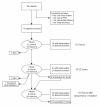Diastolic dysfunction and mortality in early severe sepsis and septic shock: a prospective, observational echocardiography study
- PMID: 22870900
- PMCID: PMC3512479
- DOI: 10.1186/2036-7902-4-8
Diastolic dysfunction and mortality in early severe sepsis and septic shock: a prospective, observational echocardiography study
Abstract
Background: Patients with severe sepsis or septic shock often exhibit significant cardiovascular dysfunction. We sought to determine whether severity of diastolic dysfunction assessed by transthoracic echocardiography (TTE) predicts 28-day mortality.
Methods: In this prospective, observational study conducted in two intensive care units at a tertiary care hospital, 78 patients (age 53.2 ± 17.1 years; 51% females; mean APACHE II score 23.3 ± 7.4) with severe sepsis or septic shock underwent TTE within 6 h of ICU admission, after 18 to 32 h, and after resolution of shock. Left ventricular (LV) diastolic dysfunction was defined according to modified American Society of Echocardiography 2009 guidelines using E, A, and e' velocities; E/A and E/e'; and E deceleration time. Systolic dysfunction was defined as an ejection fraction < 45%.
Results: Twenty-seven patients (36.5%) had diastolic dysfunction on initial echocardiogram, while 47 patients (61.8%) had diastolic dysfunction on at least one echocardiogram. Total mortality was 16.5%. The highest mortality (37.5%) was observed among patients with grade I diastolic dysfunction, an effect that persisted after controlling for age and APACHE II score. At time of initial TTE, central venous pressure (CVP) (11+/- 5 mmHg) did not differ among grades I-III, although patients with grade I received less intravenous fluid.
Conclusions: LV diastolic dysfunction is common in septic patients. Grade I diastolic dysfunction, but not grades II and III, was associated with increased mortality. This finding may reflect inadequate fluid resuscitation in early sepsis despite an elevated CVP, suggesting a possible role for TTE in sepsis resuscitation.
Figures
Similar articles
-
Prognostic Significance of Diastolic Dysfunction in Type 2 Diabetes Mellitus Patients With Sepsis and Septic Shock: Insights From a Longitudinal Tertiary Care Study.Cureus. 2023 Sep 25;15(9):e45894. doi: 10.7759/cureus.45894. eCollection 2023 Sep. Cureus. 2023. PMID: 37885490 Free PMC article.
-
Troponin elevation in severe sepsis and septic shock: the role of left ventricular diastolic dysfunction and right ventricular dilatation*.Crit Care Med. 2014 Apr;42(4):790-800. doi: 10.1097/CCM.0000000000000107. Crit Care Med. 2014. PMID: 24365861
-
Detecting impaired myocardial relaxation in sepsis with a novel tissue Doppler parameter (septal e'/s').Crit Care. 2017 Jul 14;21(1):175. doi: 10.1186/s13054-017-1727-9. Crit Care. 2017. PMID: 28705247 Free PMC article.
-
Surviving sepsis campaign: international guidelines for management of severe sepsis and septic shock: 2012.Crit Care Med. 2013 Feb;41(2):580-637. doi: 10.1097/CCM.0b013e31827e83af. Crit Care Med. 2013. PMID: 23353941
-
Left ventricular systolic function evaluated by strain echocardiography and relationship with mortality in patients with severe sepsis or septic shock: a systematic review and meta-analysis.Crit Care. 2018 Aug 4;22(1):183. doi: 10.1186/s13054-018-2113-y. Crit Care. 2018. PMID: 30075792 Free PMC article.
Cited by
-
A multicenter prospective cohort study of cardiac ultrasound phenotypes in patients with sepsis: Study protocol for a multicenter prospective cohort trial.Front Med (Lausanne). 2022 Jul 27;9:938536. doi: 10.3389/fmed.2022.938536. eCollection 2022. Front Med (Lausanne). 2022. PMID: 35966841 Free PMC article.
-
Advanced echocardiographic phenotyping of critically ill patients with coronavirus-19 sepsis: a prospective cohort study.J Intensive Care. 2021 Jan 20;9(1):12. doi: 10.1186/s40560-020-00516-6. J Intensive Care. 2021. PMID: 33472693 Free PMC article.
-
A simplified definition of diastolic function in sepsis, compared against standard definitions.J Intensive Care. 2019 Feb 20;7:14. doi: 10.1186/s40560-019-0367-3. eCollection 2019. J Intensive Care. 2019. PMID: 30820322 Free PMC article.
-
Cardiovascular risk of circulating endotoxin level in prevalent hemodialysis patients.Egypt Heart J. 2018 Mar;70(1):27-33. doi: 10.1016/j.ehj.2017.06.003. Epub 2017 Jul 28. Egypt Heart J. 2018. PMID: 29622994 Free PMC article.
-
Associations among left ventricular systolic function, tachycardia, and cardiac preload in septic patients.Ann Intensive Care. 2017 Dec;7(1):17. doi: 10.1186/s13613-017-0240-2. Epub 2017 Feb 17. Ann Intensive Care. 2017. PMID: 28213737 Free PMC article.
References
-
- Kumar A, Haery C, Parrillo JE. Myocardial dysfunction in septic shock: Part I. Clinical manifestation of cardiovascular dysfunction. J Cardiothorac Vasc Anesth. 2001;15(3):364–376. S1053-0770(01)22786-4 [pii]10.1053/jcan.2001.22317. - PubMed
-
- Kumar A, Krieger A, Symeoneides S, Parrillo JE. Myocardial dysfunction in septic shock: Part II. Role of cytokines and nitric oxide. J Cardiothorac Vasc Anesth. 2001;15(4):485–511. S1053-0770(01)34974-1 [pii]10.1053/jcan.2001.25003. - PubMed
-
- Parker MM, Shelhamer JH, Bacharach SL, Green MV, Natanson C, Frederick TM, Damske BA, Parrillo JE. Profound but reversible myocardial depression in patients with septic shock. Ann Intern Med. 1984;100(4):483–490. - PubMed
Grants and funding
LinkOut - more resources
Full Text Sources



